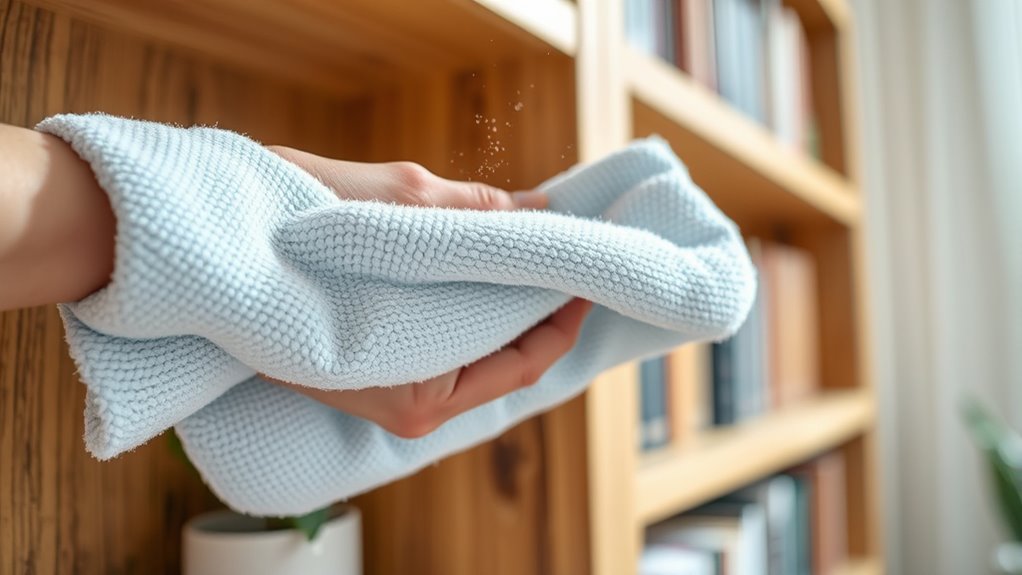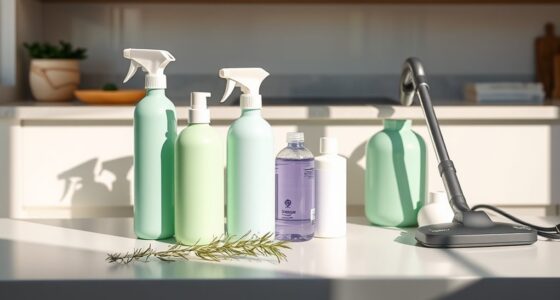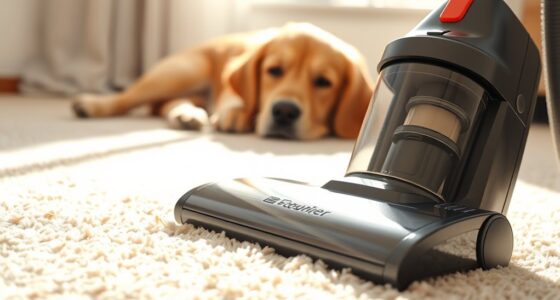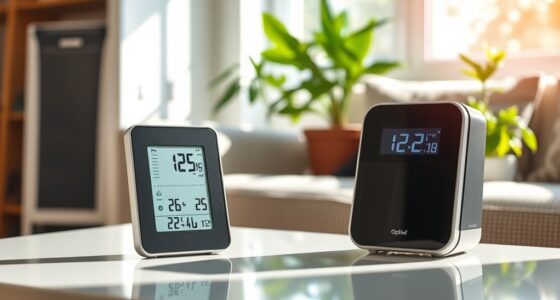By dampening your microfiber cloth, you create a powerful tool that traps allergens and dust effectively without spreading them into the air. Use a gentle, steady motion to lift and hold dust particles, preventing them from becoming airborne. This method not only speeds up your cleaning but also improves indoor air quality, especially for allergy sufferers. If you keep exploring, you’ll discover even more simple yet effective tips for a cleaner, healthier environment.
Key Takeaways
- Damp microfiber traps dust and allergens effectively, preventing them from becoming airborne during cleaning.
- Using a lightly damp cloth enhances dust capture without spreading particles or creating dust clouds.
- Gentle, steady wiping motion ensures thorough cleaning without dispersing allergens into the air.
- Microfiber’s tiny fibers lift and hold dust, reducing the need for re-cleaning and minimizing allergen circulation.
- This method improves indoor air quality by containing allergens on the cloth rather than releasing them into the environment.

Have you ever struggled to remove dust from your surfaces without spreading it around? If so, you’re not alone. Dust can be tricky to clean because it tends to scatter easily, settling into every corner and nook. That’s where damp microfiber dusting comes into play. By using a slightly moist cloth, you can trap dust particles more effectively than with dry methods. This technique not only boosts cleaning efficiency but also helps prevent allergens from becoming airborne, which is essential for allergy prevention. When you wipe surfaces with a damp microfiber cloth, the moisture grabs dust and dirt particles, holding them in place rather than pushing them around or releasing them into the air. This means fewer dust clouds floating through your home, making the environment healthier, especially for allergy sufferers.
Microfiber cloths are designed with tiny fibers that create a larger surface area, allowing them to lift and trap dust more thoroughly than traditional materials. When you add a little water or a gentle cleaning solution, it enhances their dust-catching ability. You don’t need harsh chemicals or heavy scrubbing—just a damp cloth and steady, deliberate motions will do the trick. The key is to avoid soaking the cloth too much; a lightly damp cloth is enough to attract dust without leaving surfaces overly wet. This method is especially useful on surfaces prone to static buildup, like electronics, shelves, and furniture, where dry dust can cling stubbornly. Additionally, incorporating natural cleaning methods can further improve dust removal without introducing chemicals.
Using damp microfiber dusting not only improves cleaning efficiency but also reduces the time and effort you spend on dusting tasks. Because dust particles are captured instead of kicked up, you won’t have to go over the same spot repeatedly. This makes your cleaning routine quicker and more effective. Moreover, it minimizes allergen spread, which is vital if you or your family members suffer from allergies or asthma. By trapping allergens directly on the cloth, you prevent them from becoming airborne and circulating in the air you breathe. It’s a simple change that can make a big difference in indoor air quality.
Frequently Asked Questions
Can Microfiber Dusting Be Used on Electronic Screens Safely?
Yes, microfiber dusting is safe for electronic screens when you follow proper screen safety and cleaning tips. Use a slightly damp microfiber cloth, avoiding excessive moisture, and gently wipe the screen in a circular motion. Never spray liquids directly onto the screen. This method helps prevent scratches and damage while effectively removing dust and fingerprints. Always turn off your device before cleaning to see dirt better and avoid electrical issues.
How Often Should I Damp Dust Microfiber Cloths for Optimal Cleaning?
You should damp dust microfiber cloths after every few uses, typically once a week, to maintain their effectiveness. Following the frequency guidelines helps prevent buildup of dirt and bacteria, ensuring peak cleaning. Regular cloth maintenance involves rinsing thoroughly and allowing them to air dry between uses. This keeps your microfiber cloths in top condition, allowing you to capture allergens and dust efficiently without spreading germs or debris.
Are There Eco-Friendly Microfiber Dusting Options Available?
Yes, eco-friendly microfiber dusting options are available. Look for biodegradable microfiber cloths made from sustainable materials, which decompose naturally and reduce environmental impact. These sustainable cleaning materials ensure you clean effectively while caring for the planet. By choosing biodegradable microfiber, you support eco-conscious practices and reduce waste, making your dusting routine both effective and environmentally responsible.
Does Damp Microfiber Dusting Eliminate All Types of Allergens?
Imagine a microfiber cloth gliding softly across surfaces, trapping tiny particles. Damp microfiber dusting markedly improves microfiber effectiveness in allergen removal, but it doesn’t eliminate all allergens. Some microscopic pollen or mold spores might still escape, especially if they’re deeply embedded. While it’s a powerful step for reducing dust, using it in combination with other cleaning methods offers the best chance to minimize allergens and breathe easier.
Can Microfiber Dusting Be Effective on Textured or Uneven Surfaces?
Microfiber dusting is effective on textured or uneven surfaces because its fine fibers can conform to various contours, capturing dust and allergens efficiently. You should use a damp microfiber cloth for uneven cleaning, as it enhances dirt pick-up while preventing dust from spreading. For best results on textured areas, apply gentle pressure and follow a consistent pattern, ensuring thorough cleaning without dispersing allergens into the air.
Conclusion
So, next time you grab that damp microfiber cloth, remember you’re actually wielding a secret weapon—one that traps dust and allergens instead of spreading them around. It’s funny how such a simple trick can make your cleaning routine so effective, yet so overlooked. Who knew that the key to a cleaner home was just a slightly damp cloth? Ironically, the easiest solution often turns out to be the most powerful—so go ahead, dust smarter, not harder.









